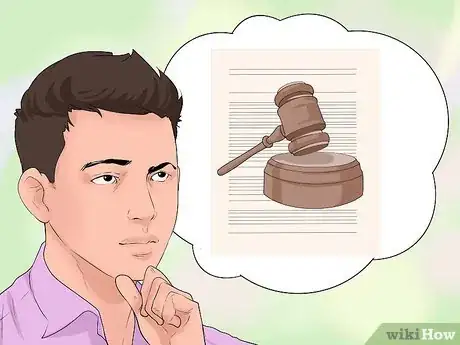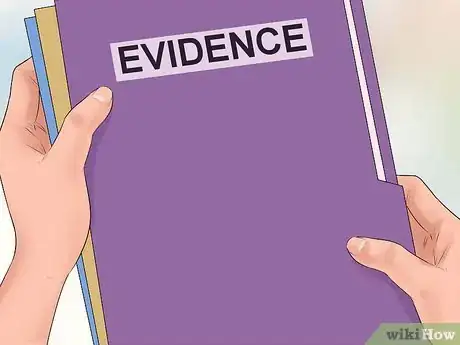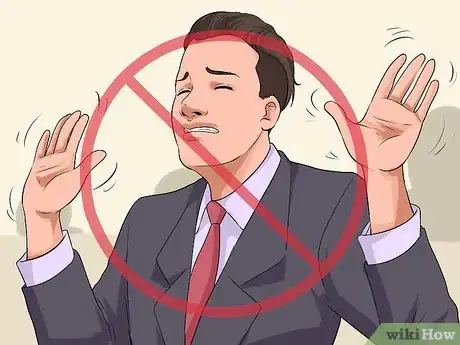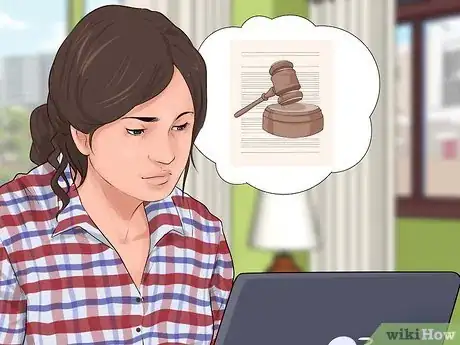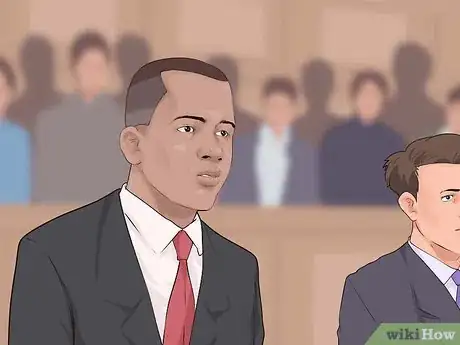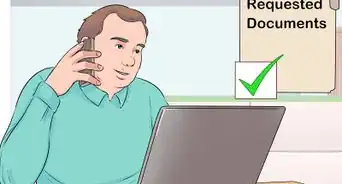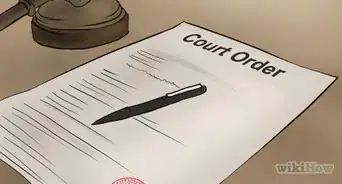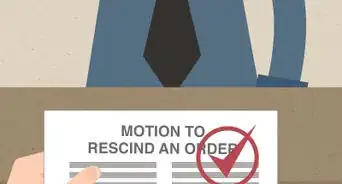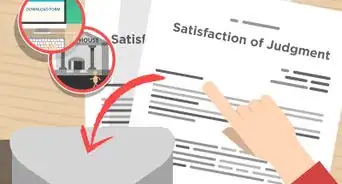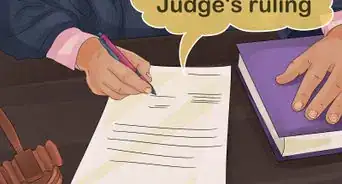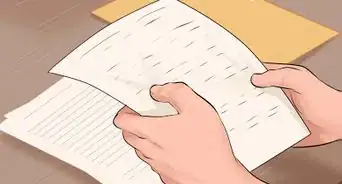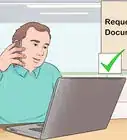This article was co-authored by Clinton M. Sandvick, JD, PhD. Clinton M. Sandvick worked as a civil litigator in California for over 7 years. He received his JD from the University of Wisconsin-Madison in 1998 and his PhD in American History from the University of Oregon in 2013.
wikiHow marks an article as reader-approved once it receives enough positive feedback. In this case, 93% of readers who voted found the article helpful, earning it our reader-approved status.
This article has been viewed 78,844 times.
The consequences of having a restraining order issued against you can be severe. Judges can mandate that the party ordered to stay away (the respondent) must pay support to the other party, relinquish the use of a shared dwelling or vehicle, turn over any guns and ammunition they may have, or pay restitution to the party requesting the order (the petitioner). Therefore, if someone has initiated a petition for a restraining order against you, it is in your best interest to mount a vigorous defense.
Steps
Preparing for the Hearing
-
1Understand how the hearing works. In many, if not most jurisdictions, the hearing for the Temporary Protection Order (TPO) is done ex parte, which means that it is done without both parties being present. The petitioner presents their evidence to the judge without the respondent being present, and the respondent presents their evidence afterwards. Don't allow this procedural quirk to put you off. Since a TPO hearing is not a criminal trial, and the judge is not determining guilt, you do not have the same right to confront your accuser as you do in a criminal trial. [1]
- Understand why TPO hearings are conducted ex parte. Even if the petitioner's request for a TPO against you is without merit, they are meritorious in many cases, and this style of hearing allows for the parties to present their cases in an atmosphere as free from intimidation as possible.
-
2Marshal your evidence. It is far too common for one party in a divorce to try and get a TPO to use as leverage against the other party with respect to visitation, custody, and spousal support. In order to fight it, you need to consider the essence of a TPO. The petitioner is claiming before a court that a preponderance of the evidence shows it is necessary for their safety that your freedom of movement and association to be curtailed. Unless you present no evidence at all, then they will need to present evidence of assaults, batteries, threats, or intimidation (depending on what type of TPO they are seeking). Try and imagine evidence they might present in their favor, and gather evidence in your own favor that contradicts it.
- An assault or battery happens at a specific place and a point in time. When and where was the alleged assault? The petitioner must show evidence that you were in that place at that point in time. If you weren't there, provide evidence beyond your word that you were someplace else. If there were witnesses to the assault, try and get the witnesses to testify or write statements on your behalf. If you expect the petitioner to present photographs showing physical harm, present evidence to show there are other explanations for how they might have received that physical harm.
- Allegations of stalking and harassment require the petitioner to demonstrate an ongoing pattern of behavior by you, the respondent. Find out what specific behaviors qualify under the statute in your jurisdiction, and anticipate how the petitioner might say that your behavior qualifies. Concentrate on showing evidence of reasonable alternative explanations for each specific incident that goes into creating the pattern of behavior.
Advertisement -
3Dress well, dress conservatively. Remember what the petitioner is alleging--that you are a person who cannot control their temper or their obsessions. Like most people, judges will unconsciously assume a wild dresser is a wild personality. Do not unintentionally corroborate the petitioner's allegation by presenting yourself as a person who cannot control basic facets of their appearance. Imagine how a judge might dress, and do your best to mimic that.
-
4Keep your emotions in check. The petitioner might make claims that are hurtful, deceptive, untrue, or all of the above. They will tell stories in ways that present you in the worst possible light, and the cast of characters in these stories will be the people that you care most about in the world. This would upset anyone. Remember,you are contesting the allegations at the TPO hearing because you feel that they are unfounded and without merit. You are not the first person to be the subject of a TPO hearing without merit, but if you lose control of your emotions at the hearing, the hearing's result will not be in your favor.
Knowing and Understanding the Terminology
-
1Understand what a restraining order is. Legally, a restraining order is an umbrella term referring to an order restraining parties in a lawsuit from doing certain things. What those things are would be specific to the facts of the case. While the legal definition of restraining order is very general, when most people say "restraining order," they mean what is called in most states a "protective order." In that sense, restraining order is a throwback term (except in California, where it is still in use), left over from the days before more specific protective order statutes were enacted. Technically, all protective orders are restraining orders, but not all restraining orders are protective orders.[2]
- A Civil Protection Order (CPO) is what most people are talking about when they say "restraining order." Broadly, there are two types of CPOs. In jurisdictions where allowed by statute, an Emergency Protection Order (EPO) is granted by a police officer or magistrate against someone arrested for domestic violence. Usually only lasting for a week, EPOs allow the alleged victim of domestic violence time to seek a more long term protective order, which is confusingly called a Temporary Protection Order.
- EPOs are granted on the basis of probable cause, the same standard on which an arrest is made. If you are the party who has been ordered to stay away by an EPO, practically, there is little that you can do about it. The required probable cause was satisfied in the officer's or magistrate's mind when the arrest was made, and since it only lasts for a week, there will be little time for you to show that the officer lacked the required probable cause when the arrest was made. [3]
-
2Decide what type of TPO applies to your case. There are three types of TPOs. A Domestic Violence Civil Protection Order (DVCPO) applies to situations where violence between intimate partners is at issue. An Elder Abuse Civil Protection Order (EACPO) applies where the abuse of dependent elderly is at issue. A Stalking/Harassment Civil Protection Order (SHCPO) applies where the issue is harassment or stalking, but not necessarily between intimate partners.
- The duration of a TPO varies greatly by jurisdiction and by the type of TPO granted. Although one year is the most common length of time for a TPO to remain in force, many jurisdictions leave it up to the discretion of the judge. Other jurisdictions mandate longer or shorter periods of time, such as six months, two years, three years, and five years.
-
3Know the standard of proof and what it means for your case. "Standard of proof" is a term describing the evidence needed to secure the petitioner or plaintiff's desired result. In a criminal case, the standard of proof requires the evidence to show the defendant is guilty beyond a reasonable doubt. Since a TPO is not the same thing as a criminal conviction (although there may be a criminal case related to the same facts at issue), the standard of proof is different than the one in a criminal case. In most states, the standard of proof for granting a TPO will require the petitioner to either show by a "preponderance of the evidence" that the facts alleged are true, or demonstrate to the judge "good cause" to grant the protection order.
- Of the two standards of proof used for protection orders, preponderance of the evidence is the more difficult burden for the petitioner to meet. Preponderance of the evidence is the evidentiary standard most commonly used in civil cases. Think of the preponderance standard in terms of percentages. When this standard is used, more than 50% of the evidence must show that the facts alleged by the petitioner are true. When the petitioner meets that 50% standard, then the judge will grant the order.
- Good cause, referred to in some states as "sufficient evidence," or "reasonable cause," is the lower evidentiary standard. Think of this standard of proof as something more than the probable cause needed to make an arrest, but less than the preponderance of the evidence standard.
- Since TPO statutes were enacted to protect victims of domestic violence, elder abuse, and stalking from violence and harassment before the commencement of a civil or criminal trial, less evidence is often required to secure a TPO than is required to prove criminal or civil liability. A TPO is not the same thing as a guilty verdict or being found civilly liable. Particularly when a good cause standard is used, a petitioner would need to show much more evidence to prevail at trial than at a TPO hearing.
-
4Understand the consequences. A TPO hearing is not something to take lightly. There are serious consequences to having a protective order enforced against you, and they are dependent upon the type of protective order in force.
- If you, the respondent, are the losing party at a DVCPO hearing, you will lose your right to posses a firearm. While the police should come and confiscate your firearms, even if they don't, as long as you have firearms in your possession, you will be in violation of the protective order and can be subject to penalties on that account. If you are subsequently found guilty of a criminal domestic violence charge, you will lose your right to posses firearms permanently. [4]
- If you and the petitioner have children together, you can temporarily lose your right to custody and visitation while the protective order is in force, for as long as the protective order is in force. Even if you and the petitioner are unmarried, or a divorce is pending, you can still be ordered to pay child and spousal support for as long as the protective order is in force.
- You can be ordered out of your own house, and temporarily banned from using a shared automobile. The judge can also order a losing respondent to pay any costs associated from getting the TPO itself, such as attorney's fees, medical bills, and childcare expenses. [5]
References
- ↑ http://www.fultoncourt.org/family/family-domviol.php
- ↑ http://family.findlaw.com/domestic-violence/domestic-violence-orders-of-protection-and-restraining-orders.html
- ↑ http://family.findlaw.com/domestic-violence/domestic-violence-orders-of-protection-and-restraining-orders.html
- ↑ http://family.findlaw.com/domestic-violence/domestic-violence-orders-of-protection-and-restraining-orders.html
- ↑ http://www.womenslaw.org/laws_state_type.php?id=11169&state_code=GE
About This Article
Although fighting a restraining order can seem overwhelming, a good place to start is by collecting evidence of your innocence. For example, try to find witness testimony or proof that you were somewhere else. Then, prepare for the hearing by dressing conservatively in order to make a good impression on the judge. During the hearing, present your evidence while keeping your emotions in check, since getting angry or losing control can hurt your case. For more advice from our Legal reviewer, including how to differentiate between the various types of protective orders, read on.
